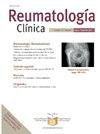纤溶酶原激活物抑制剂-1对人软骨细胞无支架球体细胞外基质稳态的影响
IF 1.2
Q4 RHEUMATOLOGY
引用次数: 0
摘要
骨关节炎研究的新趋势是生物疗法的应用;在这种情况下,使用纤溶酶原激活物抑制剂-1 (PAI-1)被认为是防止骨关节炎(OA)治疗中细胞外基质(ECM)降解的潜在治疗策略。然而,体外研究尚未证实其对ECM稳态相关基因表达的影响。方法利用人OA软骨源性软骨细胞在缺氧条件下生成无支架球体。将球体暴露于PAI-1 24 h,测定细胞活力。然后用qRT-PCR分析ECM组分和降解酶COL2A1、SOX9、ACAN、COL1A1、MMP3、MMP9、MMP13、ADAMTS4、ADAMTS5、TIMP1、TIMP2、TIMP3、uPA和tPA的表达情况。结果spai -1治疗可持续维持细胞活力和软骨细胞球体完整性。在50 ng/mL浓度下,PAI-1增加COL2A1基因的表达,降低SOX9、ACAN、MMP3、MMP9、TIMP2和tPA的表达。此外,在pai -1处理的球体中,COL2A1/COL1A1的功能比值显著增加。结论PAI-1治疗对球体的ECM具有复杂和多方面的影响。虽然它通过降低ECM重塑酶(如MMPs和ADAMTS5)的基因表达来支持基质完整性,但它也会诱导软骨形成相关标记基因(如SOX9和ACAN)的不利变化。这些发现表明,细胞对PAI-1的反应不是单向的,需要进一步研究以了解其确切的生物学意义。本文章由计算机程序翻译,如有差异,请以英文原文为准。
Effect of Plasminogen Activator Inhibitor-1 on extracellular matrix homeostasis in scaffold-free spheroids from human chondrocytes
Introduction
New trends in osteoarthritis research focus on the use of biological therapy; in this context, the use of Plasminogen Activator Inhibitor-1 (PAI-1) is considered a potential therapeutic strategy to prevent extracellular matrix (ECM) degradation in osteoarthritis (OA) management. However, in vitro studies have not demonstrated its effect on the expression of ECM homeostasis-related genes.
Methods
Human OA cartilage-derived chondrocytes were used to generate scaffold-free spheroids under hypoxia conditions. The spheroids were exposed to PAI-1 for 24 h, and cell viability was measured. Then qRT-PCR was used to analyze the expression of ECM components and degradative enzymes, including COL2A1, SOX9, ACAN, COL1A1, MMP3, MMP9, MMP13, ADAMTS4, ADAMTS5, TIMP1, TIMP2, TIMP3, uPA and tPA.
Results
PAI-1 treatment consistently maintained cell viability and chondrocyte spheroid integrity. At the 50 ng/mL concentration, PAI-1 increased the gene expression of COL2A1 and reduced SOX9, ACAN, MMP3, MMP9, TIMP2, and tPA. Moreover, the functional COL2A1/COL1A1 ratio was significantly increased in PAI-1-treated spheroids.
Conclusion
Our results suggest that PAI-1 treatment exerts a complex and multifaceted influence on spheroids’ ECM. While it supports matrix integrity by reducing the gene expression of ECM remodeling enzymes, such as MMPs and ADAMTS5, it also induces unfavorable changes in chondrogenesis-related marker genes, such as SOX9 and ACAN. These findings indicate that the cellular response to PAI-1 is not unidirectional, warranting further investigation to understand its precise biological implications.
求助全文
通过发布文献求助,成功后即可免费获取论文全文。
去求助
来源期刊

Reumatologia Clinica
RHEUMATOLOGY-
CiteScore
2.40
自引率
6.70%
发文量
105
审稿时长
54 days
期刊介绍:
Una gran revista para cubrir eficazmente las necesidades de conocimientos en una patología de etiología, expresividad clínica y tratamiento tan amplios. Además es La Publicación Oficial de la Sociedad Española de Reumatología y del Colegio Mexicano de Reumatología y está incluida en los más prestigiosos índices de referencia en medicina.
 求助内容:
求助内容: 应助结果提醒方式:
应助结果提醒方式:


